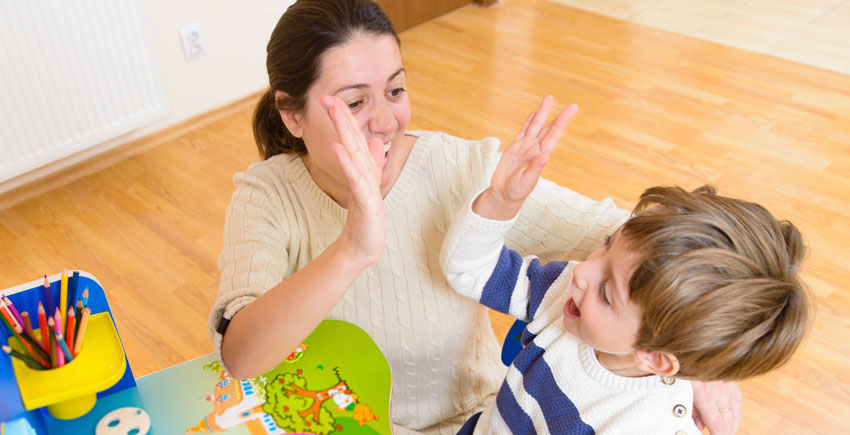Intensive Interaction
Intensive Interaction involves the adult interacting with the child, preferably in an open space devoid of objects, toys and distractions. The adult’s focus is to “advertise” themselves as an interesting communication partner, facilitating opportunities for the child to feel validated. In brief the basics are for the adult to follow the child’s interest, copy their actions and vocalisations. Intensive Interaction provides an exciting platform from which the child is learning in order to:
- Have fun!
- Explore and experiment, use touch and proximity.
- Attend and engage, co-operating with another person.
- Read non-verbal signals and cues.
- Develop appreciation that “my noises and vocalisations have meaning”
- Make choices and develop cause and effect
- Develop appreciation about their effect on their immediate environment
- Experience positive feeling that being with another person is good
- Develop trust and support them in feeling validated; “My behaviours are important”

Bobby’s story
Let me tell you a story about a little boy, let’s call him ‘Bobby’.
When Bobby and his parents first came to Sensation Station, Bobby displayed reduced eye contact and did not respond when his name was called. He had a fixation to objects of interest and a preference for running around. The described profile his mother provided during the parent consultation matched Bobby’s presentation during early therapy session at Sensation Station. Bobby displayed fleeting attention and was moving quickly between the given toys and activities.
During the discussion with his parents, Intensive Interaction was mentioned as part of the therapy intervention. Bobby’s parents were keen to obtain some information about Intensive Interaction and were also provided with strategies by the therapist to carry over this approach at home.
Background information on Intensive Interaction
It was developed by Dave Hewett in 1980’s, during the time that he was working as a headteacher of a special school in the UK. He developed Intensive Interaction for the use with children whose primary difficulties were in the areas of sociability and fundamental communication skills. It promotes short parent-child interaction sequences, encouraging the child to become an active participant in interactions with others.
Aims include supporting the child to:
- Enjoy being with another person
- Develop the ability to attend to that person
- Develop concentration and attention span
- Share personal space
- Obtain and understand eye contact
- Use and read facial expression
- Use and understand body language
- Take turns
- Imitate motor actions
- Start using noises/vocalisations functionally
What is Intensive Interaction?
Autism and Intensive Interaction
Back to Bobby’s story
The outcome, following a block of eight therapy sessions at Sensation Station, was that Bobby demonstrated improved use and maintenance of eye contact, meaningful and spontaneous smiles and an awareness and anticipation of familiar activities such as rolly-polly. He also initiated activities of interest looking to the adult’s response and participation, for example, tapping the wall. Bobby is more responsive to his name and outside the therapy environment he has been seen waving, greeting and saying goodbye.
Bobby is no longer only reliant on objects of interest to keep himself entertained but is observed copying the gross motor actions during songs and activities. His parents plan to continue implementing Intensive Interaction at home. He will benefit from opportunity to generalize his skills across his interaction environments. Collaboration between the Sensation Station Centre and Bobby’s nursery has allowed the nursery staff to be empowered with the same approach. His nursery staff are now implementing short Intensive Interaction sessions for Bobby every day. They are already commenting on the positive changes they are observing.
At Sensation Station we try to reach out and help as many families as possible within a holistic approach and a multidisciplinary setting. Intensive Interaction appears to be effective and is not just for individuals with learning disabilities and autism, but for all of us. All humans need social engagement with others for our mental health and happiness.
Here are some links to further reading on Intensive Interaction:
Dave Hewett
Phoebe Caldwell

